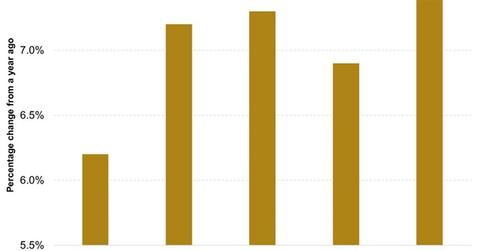Reserve Bank of India Sees India on Firm but Uneven Ground
Industrial production remains a problem for India, with the RBI (Reserve Bank of India) noting that the index measuring industrial production decelerated in fiscal 2015–16.
June 9 2016, Updated 9:06 a.m. ET

Economic growth surprises
India’s GDP was a pleasant surprise in the quarter ending in March 2016. In India, the fiscal year begins in April and ends in March of the succeeding year, making the aforementioned period the fourth quarter of fiscal 2015–16.
India’s GDP rose by 7.9%, while GVA (gross value added) rose by 7.4%. The relationship between GDP and GVA is as follows:
GDP = GVA + taxes on products – subsidies on products
The base year for calculating India’s GVA is 2011–12. It used to be 2004–05.
In fiscal 2015–16, India’s GVA rose by 7.2%, marginally better than the 7.1% rise reported for fiscal 2014–15. Meanwhile, GDP rose 7.6% in 2015–16, compared to 7.2% in the previous fiscal year.
The GVA growth for fiscal 2015–16 was a little lower than expected as all industry segments in the service sector reported a slowdown in activity compared to the previous fiscal year. On the other hand, manufacturing activity surged, and agriculture grew after contracting in the previous fiscal year.
On firm ground
In its monetary policy statement for June 2016, the RBI (Reserve Bank of India) stated, “Some high frequency indicators for April point to a firming recovery, although it is still uneven.” Among the positive points, the RBI counted cargo traffic at major ports, automobile sales (specifically two-wheelers and three-wheelers), commercial vehicle sales, passenger air and freight traffic, cement production, and steel consumption.
Industrial production remains a problem for the country, with the RBI noting that the index measuring industrial production decelerated in fiscal 2015–16. Exports also continued to hurt as the global economy remains subdued.
However, the RBI noted, “There are signs that corporate performance is improving. Available information on Q4 earnings suggests double digit growth in EBITDA levels for non-financial corporates.”
This can be good news for investors in India as a firmer economy and improving corporate performance would benefit Indian equities and mutual funds (MINDX) (FINGX) as well as ETFs (EPI) (PIN) (INDA) investing in them.
Going forward, policy transmission, in addition to inflation, remains key for the RBI, in order to further reduce the repo rate. We’ll discuss policy transmission in more detail in the next article in this series.
